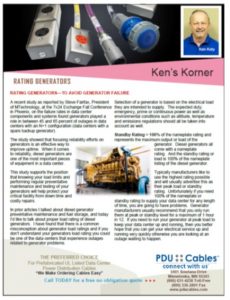KEN'S KORNER - Rating Generators
Rating Generators - To avoid Generator Failure
A recent study as reported by Steve Fairfax, President of MTechnology, at the 7x24 Exchange Fall Conference in Phoenix, on the failure rates in data center components and systems found generators played a role in between 45 and 65 percent of outages in data centers with an N+1 configuration (data centers with a spare backup generator).
The study showed that focusing reliability efforts on generators is an effective way to improve uptime. When it comes to reliability, diesel generators are one of the most important pieces of equipment in a data center.
This study supports the position that knowing your load limits and performing regular preventative maintenance and testing of your generators will help protect your critical facility from down time and costly repairs.
In prior articles I talked about diesel generator preventative maintenance and fuel storage, and today I’d like to talk about proper load rating of diesel generators. I have found that there is a common misconception about generator load ratings and if you don’t understand your generators load rating you could be one of the data centers that experience outages related to generator problems.
Selection of a generator is based on the electrical load they are intended to supply. The expected duty; emergency, prime or continuous power as well as environmental conditions such as altitude, temperature and emissions regulations should all be taken into account as well.
Standby Rating = 100% of the nameplate rating and represents the maximum output or load of the generator. Diesel generators all come with a nameplate rating. And the standby rating or load is 100% of the nameplate listing of the diesel generator.
Typically manufacturers like to use the highest rating possible and will usually advertise this as their peak load or standby rating. Unfortunately if you need 100% of the nameplate or standby rating to supply your data center for any length of time, you are going to have problems. Generator manufacturers usually recommend that you only run them at peak or standby level for a maximum of 1 hour in 12. If you need to run your generator at peak load to keep your data center up and running, then you better hope that you can get your electrical service up and running very quickly otherwise you are looking at an outage waiting to happen.
Prime Rating = 90% of the nameplate rating and represents the maximum output that should be planned for while permitting the occasional 10% spike in capacity demand. Office buildings or manufacturing facilities are good examples of generators being operated at prime rating, where consumption may cause an occasional 10% overload in demand, but typical load demand is steady and short lived. Most manufacturing and office environments operate in peak and off peak hours usually following the typical workday energy demand. This on and off-peak period usage varies enough to permit the generator winding's to cool down during lower load periods.
Continuous Rating = 82% of the nameplate rating. While at my data center our generator had a manufacturer’s continuous rating of 85%, the data center engineering firm we worked with recommended that we use a continuous rating of 82% to allow some cushion. At 82% we projected that the data center could run on an indefinite basis.
Our engineering firm believed that a data center running 7x24 with a load that doesn't typically vary much throughout the duration of the run, should establish a red line at 90% of the standby rating, thus extending the life and reliability of the diesel generators.
In our case we employed 2000 kilowatt generators, as per their nameplate rating (Peak or Standby) the generators could generate a maximum of 2000 kilowatts of power. At prime rating of 90%, this generator could supply 1800 kilowatts of power. At our continuous rating of 82%, we could confidently generate 1640 kilowatts of power indefinitely and still allow for spikes in energy demand without worry about overtaxing or damaging our generators.
If your power needs exceed the power capacity of your generators at continuous rating, I recommend you re-balance the loads or upgrade your generator capacity.
Each and every day our goal was uptime. We recognized that an outage could cost our company hundreds of thousands if not millions of dollars in revenue, so we couldn't risk outages in either the short term due to exceeding generator standby capacity, or long term due to generator failure.
If you want to make sure that you don’t experience power outages due to generator failure, run your generators at the appropriate load rating (data centers 82%), and balance your loads accordingly. And don’t forget our prior discussions on preventative maintenance and fuel storage.
Ken Koty

